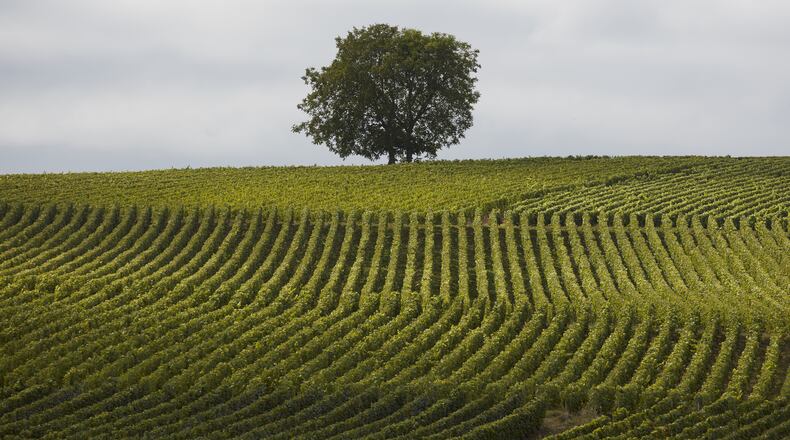When Armand-Raphael Graser moved from his native Alsace, France, to the Champagne region in 1915, World War I was raging. He purchased a house built in 1772 and from there launched Champagne AR Lenoble in 1920.
Unlike many of his German neighbors, who had moved to Champagne in the 18th and 19th centuries, Graser chose not to use his own name for the wines he made, believing a German-sounding name in post-World War I France would be too much of a liability for a new business.
He chose the name Lenoble instead, applying his initials to make the family mark. Today, nearly 100 years later, AR Lenoble is the quintessential "grower Champagne," a term that has grown in popularity in recent years even though grower producers in Champagne have been around as long as Champagne itself.
Most of the Champagne consumed around the world is produced by large Champagne houses such as Moet & Chandon, Veuve Clicquot and Roederer. The big houses tend to purchase most, if not all, of the grapes used in their Champagnes, putting tremendous pressure on the many small growers in the region to simply grow grapes and sell them rather than produce their own wines.
AR Lenoble, however, remains true to its founding vision, a vision perpetuated by Anne and Antoine Malassagne, great-grandchildren of Graser. Anne Malassagne took over the business side from their father. Antoine Malassagne is the passionate winemaker, keeper of the family legacy and protector of its prized 10-hectare chardonnay vineyard planted in the chalky soils of the grand cru village of Chouilly. Lenoble also has 6 hectares of pinot noir in the premier cru village of Bisseuil and 2 hectares for pinot meunier in the soils around Damery.
Assuming the role of winemaker at the tender age of 23, Malassagne has imbued AR Lenoble with a very precise point of view. The essence of his philosophy, at its most basic level, is to highlight the winery's grand cru chardonnay vineyard in Chouilly at nearly every turn.
For example, the AR Lenoble Rose Terroirs Chouilly-Bisseuil is that rare rose Champagne that is chardonnay-dominant at 88 percent. "I don't focus on color," he explained recently. "The color could be slightly different each batch. I use 90 percent chardonnay to get the finesse and elegance. This is rare in Champagne."
Malassagne also holds to a minimum of three years of aging on the yeast lees for every Champagne, despite the fact that the laws governing Champagne require just 15 months. And he is among a growing handful of producers who believe lower dosage levels enhance the expression of terroir in any Champagne.
The legal limit for sugar in a brut Champagne is 12 grams per liter, but most of the AR Lenoble Champagnes come in at 6 grams or less.
Stylistically, Malassagne strives for an oxidative style that he achieves through the use of barriques and large wooden casks in the winemaking process. Small amounts of oxygen help the Champagnes develop mature aromas that are richer and slightly nutty compared to Champagnes that only see stainless steel vats.
One of his proudest achievements is the AR Lenoble Brut Nature, a zero-dosage brut that has become quite popular. Brut zero Champagnes are not to everyone's taste because the lack of sugar to balance the acid can result in wines that are sharp and unpleasant.
AR Lenoble makes a number of prestige cuvees, most notably Cuvee Les Aventures Grand Cru Blanc de Blancs. Only three cuvees of La Aventures have been produced in Malassagne's 20 years in the cellar. The first was a cuvee that combined the exceptional 1990, '95 and '96 vintages. The second paired 1996 and 2002, and the current release represents the excellent 2002 and 2008 vintages.
The 1996 vintage is legendary in Champagne, and it was young Antoine's first at the helm. "I made the decision in 1996 to block the (malolactic fermentation, which softens the acidity) to age the wine for a very long time," he said.
Aged 20 years on the lees, it was disgorged in January of this year. Despite its age, the color is a pristine pale straw. The freshness on the palate is astonishing. It exhibits exceptional richness and length in the mouth. And it fits Antoine's notion of what a vintage Champagne should be.
"A vintage Champagne should shock you," he said. "It should have the ability to age."
I daresay, no large Champagne house would sit on a great vintage for a couple of decades. Heads would likely roll. But for a small grower with a mere 8,000 bottles, this Champagne for the ages turns out to be a grand gesture for the winemaker's 20th anniversary on the job.
"It takes patience," he said. "I get frustrated sometimes. People don't know how long it takes to make a great wine. It is a long work."
Now we know. If ever there was a time to raise a glass of bubbly in celebration, Antoine Malassagne of AR Lenoble has earned it.
About the Author
The Latest
Featured


